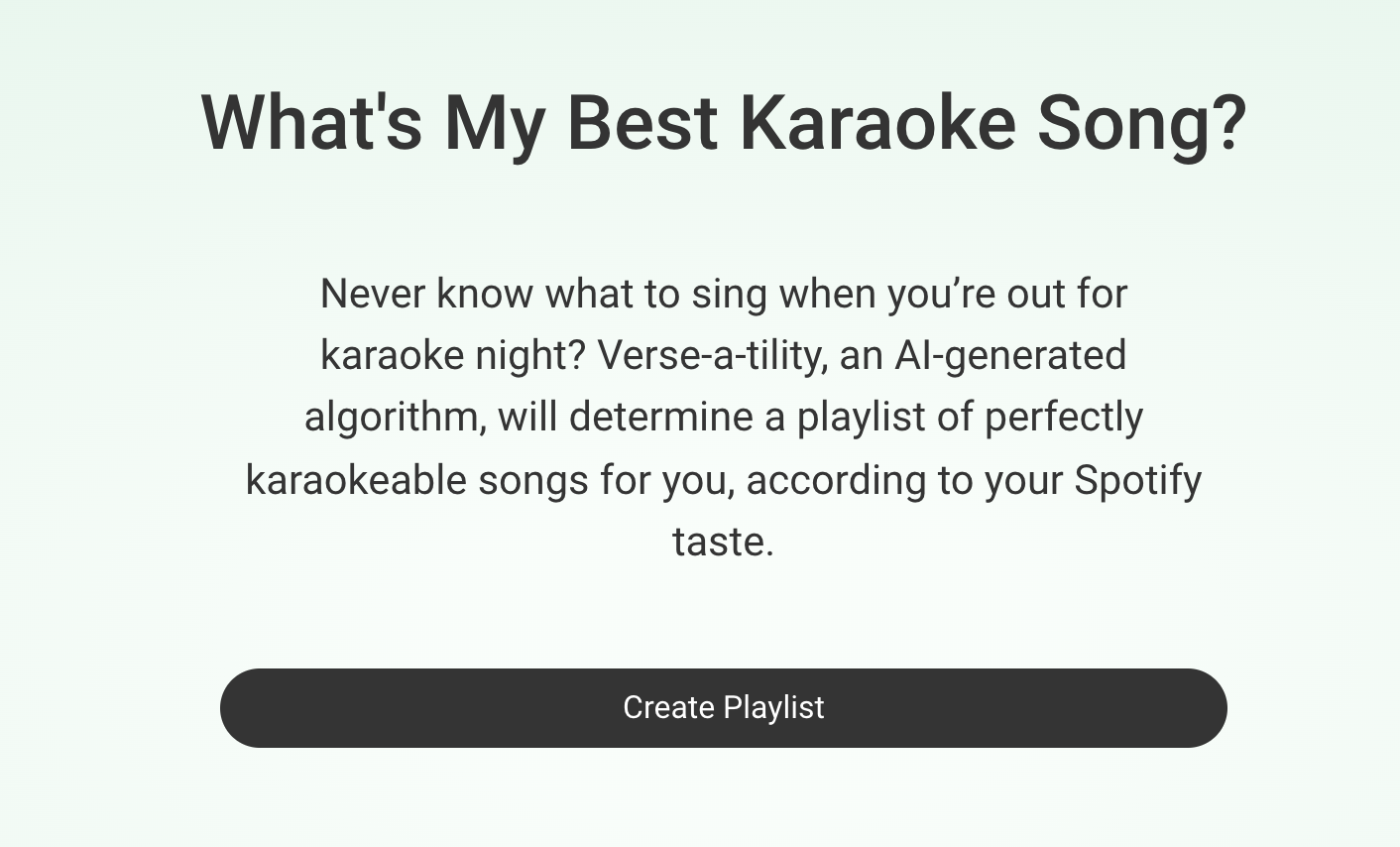
c/o verseatility.co
Song selection is critical at any karaoke party. To help, Daniel Knopf ’22, Nalu Tripician ’22, and Isabel Wrubel ’22 recently redesigned and launched an app, Verse-a-tility, that curates a playlist of the 10 best karaoke songs from a user’s Spotify library.
To create playlists for users, the app’s algorithm rates songs based on “karaokeability,” which is their similarity to tracks that are known to be good for karaoke. It compares them using Spotify’s publicly available metrics, including tempo, key, and “danceability.”
“We use a neural network that we designed that basically takes all of [those metrics]…and then spits out a karaokeability score,” Tripician said.
After starting the project during a hackathon in 2019, Tripician and Knopf worked on the app intermittently until summer 2021.
Each member of the team has contributed something different. For instance, Tripician primarily worked on the app’s algorithm.
“My role was more just working on the back end,” Tripician said. “I [developed] the machine learning algorithms that say if [a song is] a good karaoke song or not, and also I deal with everything on the Spotify end, such as playlist creation. Then I pass…the data that I get over to Daniel’s side, so he can display it.”
Knopf works on web development, which involves storing users’ music data on a server and displaying their results on the app’s website.
“The page that users visit…is verseatility.co, and that is front-end web design, which I built in this framework called React,” Knopf said. “Then we have a back-end server, which is separate. We put a computer running somewhere else that has all of our data…. I have them connect so that all the data is shared between the two in a safe and secure manner.”
Wrubel joined the team in the summer of 2021 to revamp the website’s graphics. The app’s user interface was kept minimal, with a light green radial gradient to give a karaoke feeling to their website and mimic the experience of Spotify Wrapped.
“I’m largely responsible for the design,” Wrubel said. “I’m working in Figma to build out a design using [user experience and user interface] principles.”
Wrubel needed to keep Tripician’s work with machine learning in mind when designing the website.
“In order for our [machine learning] algorithm to improve, we needed users to rate each individual song,” Wrubel wrote in an email to The Argus. “This was tricky from a [user experience] perspective. [I] decided to make the flow a series of ten pages where a user could only get their entire playlist once they individually rated each of their songs.”
Initially, the team calibrated the algorithm by using a web scraper—a software tool that harvests data from websites—to find good karaoke songs. They also manually evaluated over 1000 songs, which Tripician assembled. Some of these tracks, including classical music, were quickly assigned a low rating.
“[Tripician] put the entire Minecraft soundtrack in [to be rated],” Knopf said. “I was like, ‘All right, automatic zero.’”
The app also asks users to rate the songs they receive, and the algorithm adjusts its recommendations accordingly.
The team noted that some users received lackluster playlists because they simply don’t listen to karaokeable music much. Another issue that has emerged is that users sometimes can’t remember their Spotify username and password, which they need to type into the website.
Overall, however, the team hopes that gaining users will help them discover any lingering bugs in the website’s design.
“What we really want to hear is if you use it and it doesn’t work,” Knopf said. “We would love for you to get in contact with us. We just added some logging and data analysis stuff…so we can try to figure it out.”
In the future, the developers want to expand the app’s reach and abilities.
“We’re working to add a few more features such as getting an overall karaokeability score for your entire library,” Knopf said.
Other goals include lengthening the playlists to 25 or 50 tracks, allowing users to look up the karaokeability ratings of specific songs, and displaying aggregated data about songs and artists on the website. The team envisions a model similar to Spotify Wrapped, where users can post a list of their top karaoke songs on social media.
“We think that it…has a lot of potential to be shared around a lot and be used by people outside of Wesleyan,” Knopf said. “We’re trying to add on more features and figure out what’s the best way to make it go big.”
Nalu Tripician is the Web Editor for The Argus.
Daniel Knopf was an Assistant Opinion Editor for The Argus.
Caleb Henning can be reached at chenning@wesleyan.edu.
Anne Kiely can be reached at afkiely@wesleyan.edu.
Comments are closed